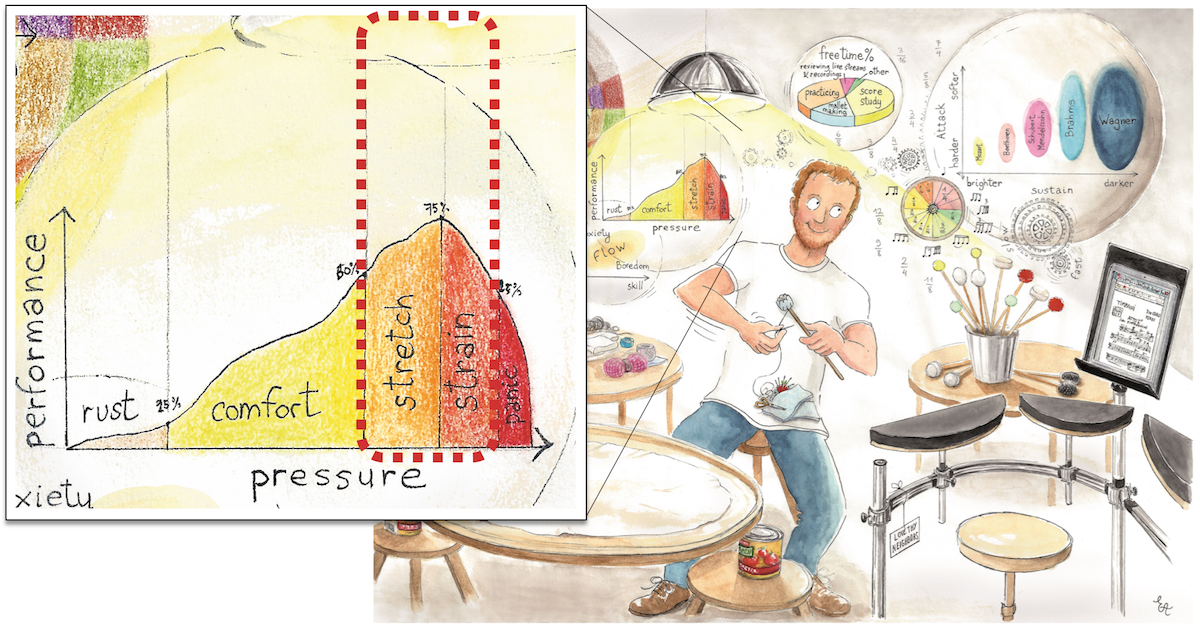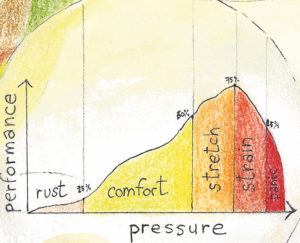(The Attributes of Deliberate Practice: Design and Intention)

How many times have you ambled into your practice room, setup your instrument, gotten yourself situated, and then thought, “Okay…now what?”
Yep — same here. That used to happen to me far too often. And here’s the bad news: whatever might happen after that, it’s not deliberate practice.
That’s because one of the defining attributes of deliberate practice is that it’s designed. It’s planned out in advance, thoughtfully and intentionally, with a sense of both where you’re going and how you get there. It is not random. It is not haphazard. And it is certainly not, “Huh…what do I feel like playing today?”
No – your time is extremely valuable, and you should spend it very specifically. Your practice should be highly intentional. (Have you been to a yoga class where your teacher says “set your intention for your practice?” This is pretty much the exact same thing.) And your practice should be intentional by design.
“Design.” There’s a lot packed into this simple idea — this first toe-hold up the mountain of deliberate practice. “Design” both assumes and implies a great deal, so let’s break it down….
Continuing the analogy to any kind of yoga or physical training, one implication of “design” is adaptability. Your practice should be tailored to you, and to where your skills reside at this particular moment in time. You won’t necessarily need to practice all of the exact same things 5 years from now, just as you probably didn’t practice the same things 5 years ago as you do today. Consider an Olympic weightlifter: there are certainly general principles that will guide anyone’s training, but their specific routine will need to be customized. You can’t just take a newbie in the beginning of their training regimen and say “okay, go deadlift 1155 pounds” (the current world record). Your practicing should depend on your context. Your deliberate practice should be tailored.
This provokes a natural question: who does the tailoring? Answer: you and your teacher. We’ll discuss the importance of teachers at length in future posts, but their impact on design is critical: until you’ve achieved a sufficient level of self-awareness and self-analysis, the design of your practice process itself almost certainly requires coaching. (Among other things, teachers see you in ways that you cannot see yourself.)
This involves an assumption: teachers exist within your field (e.g., music performance) who possess a comprehensive understanding of its history, effective training techniques, and pedagogical methods. A core assumption of effective deliberate practice is that it must happen within the “fertile soil” of a “highly developed field,” where experts have been standing on each others’ shoulders and pushing the boundaries of performance for decades, if not centuries. A highly developed field is one in which practice can be informed by the training regimens of its most elite performers.
Next, a requirement: well-designed deliberate practice requires you to work outside of your comfort zone. It requires you to push your limits and constantly expand your territory of “what’s possible”…but without careening into the zone of panic, desperation, and zero-productivity. Noel Tichy famously coined the “learning zone” phrase, and I think Emmanuelle beautifully captured how it’s approached with increasing “practice pressure”:
“Practice pressure” is a distillation of focus, effort, and concentration. It requires non-trivial amounts of practice pressure to break out of your comfort zone, sort of like the massive rockets the space shuttle required to achieve escape velocity from the comfort of Earth’s atmosphere. Beyond your comfort zone, you are stretching and straining — the uncomfortable hallmarks of the “learning zone.” Deliberate practicing shouldn’t be easy. It shouldn’t be a breeze. If you’re not fatigued at the end of a practice session, you’re probably doing it wrong. (Or at least, not as efficiently and effectively as you could be.)
Younger students might not always understand the boundaries of their own comfort zones. Conspicuously, many students will want to sprint before they can crawl, taking passages far too quickly, or trying to tackle works that are simply beyond their technical capacity. (I have to wonder how many teachers silently echo Master Yoda when their students rush into repertoire far beyond their skills:  “Unfortunate…incomplete was your training. Not ready for the burden were you.”) Let’s assume you can keep all of your limbs intact: rushing beyond your training is still massively counterproductive, for reasons we’ll elaborate when we get to the neurology of deliberate practice. But an expert teacher can help design practice that takes you out of your comfort zone without pushing you into panic. Moreover, new skills should be built on top of existing skills. This requires teachers to provide fundamental skills as a foundation on top of which new skills can be built. Existing skills are comfortable, but new skills should stretch.
“Unfortunate…incomplete was your training. Not ready for the burden were you.”) Let’s assume you can keep all of your limbs intact: rushing beyond your training is still massively counterproductive, for reasons we’ll elaborate when we get to the neurology of deliberate practice. But an expert teacher can help design practice that takes you out of your comfort zone without pushing you into panic. Moreover, new skills should be built on top of existing skills. This requires teachers to provide fundamental skills as a foundation on top of which new skills can be built. Existing skills are comfortable, but new skills should stretch.
Once you’ve applied the pressure to get out of your comfort zone, what do you do once you arrive in the stretching zone? That’s the “deliberate” part: deliberate practice involves well-defined and highly specific goals. And these goals cannot just be “play it better” or “play it faster.” Ideally, a teacher develops a plan for making a series of small changes which will add up to a larger change; the student then compares before-and-after performances to verify the improvement. (This is an element of “feedback” we’ll get to in the next post.) This all necessarily implies honestly assessing your weaknesses, and focusing intently on improving those. (Or, for younger students, it implies actually believing your teacher when they say “this is a weakness we’ll need to work on.”) Sure, it’s more fun to cruise through the stuff you’ve already mastered…but that’s doing virtually nothing to improve your skills. And here’s the thing: focusing intensely on your weaknesses is not as easy as it sounds. It’s grueling, it’s painful, and it can become demoralizing if you lose track of the design of the bigger picture. It requires true intention. It also comes face to face with one of the biggest frictions of practicing: your ego.
Well-defined goal-setting requires introspection and honesty, and that demands a surrender of ego. Future posts will discuss the most productive ways to remove painful emotions from this process. But if you ever find yourself caught in a negative loop of self-recrimination after focusing on your weaknesses, just remember: your job is to vibrate air at people. This is not life-or-death.
Finally, well-designed deliberate practice is crafted for massive repetition. When approached thoughtfully, your practice will support massive repetition. Engaged with intention, your practice should be constructed so that it can be repeated. Again. And again.
And again.
Seriously. Good practicing requires massive repetition. This is another topic we’ll explore further when we get to the neurology of deliberate practice, but here’s the quick version: there’s a very specific biochemical reason for massive repetition, and it’s based on a protein called Myelin. For now, though, consider the great practicing adage:

Repetitively encoding the “right” way to do something is key to deliberate practice. Repetitively encoding the “right” way to do something is key to deliberate practice. Repetitively encoding the “right” way to do something is key to deliberate practice…both from the perspective of neurobiology and from the perspective of performance psychology. You are creating and insulating the mental circuitry that enables consistency – a key concept for almost any kind of high-level performance in any field. Well-designed deliberate practice is crafted for massive repetition. MASSIVE. Repetition. A lot.
So…are you comfortable yet? I HOPE NOT! Get out of that comfort zone, and design your practice with intention!
Also, Cloud City is a trap.


